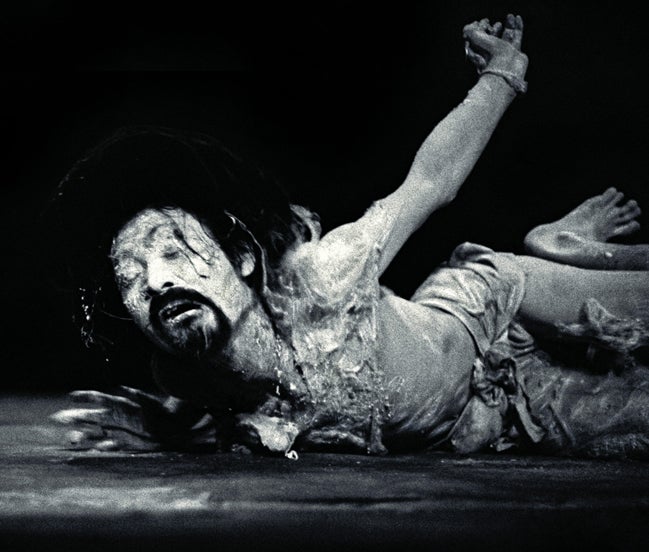Nonfiction by Shilpi Suneja for MQR Online.
I came to Banaras in the winter of 2010 seeking an answer to one question: was the sari — the nine-yard piece of cloth worn by Indian women — Hindu or Muslim? This might sound like an odd question, but in the context of India it isn’t, where even allegedly eating beef can get a person beaten to death, or while killing a cow in the state of Gujarat earns life imprisonment. In such a cultural climate it becomes important to document the understudied, the silent side of things.

As my taxi made its way from the airport into the city, I watched a dozen or so Hindu women circumambulating a tree outside a mosque, plates piled with flowers and fruits. It wasn’t a pepul, a neem or banyan, trees traditionally holy to Hindus, and my driver, Shabbir Khan concluded that a recent miracle in the vicinity might be the cause for the devotion. “The mosque-goers don’t mind all the chanting?” I asked, and Shabbir said, “What can they do? They have to compromise.” While Shabbir stalled the car to allow the Hindu women to cross the highway I thought about how quickly icons turn into idols, and idols turn into gods. I wondered if the little tree, newly deified, might force the mosque to shut down, so that the Hindus could claim the tree and the land nearby.
It’s always been this way in India. Symbols engage in a daily battle. Origins of things are routinely questioned. False histories are invented for political gains leading to events that affect the lives of millions. Take for example the tragedy that befell the Babri Mosque. Built in the sixteenth century by Babur, the first Mughal ruler, the mosque came under fire because it was erected on land that was allegedly the birth place of Lord Rama. Evidence of Rama’s birth was never presented, mythological as the Hindu king was, and yet the baseless historical hurt galvanized Hindu fanatics all over the nation, who on the fateful morning of December 6, 1992 razed the mosque to the ground. Rioting and curfews engulfed the country. Things changed forever. The pro-Hindu right-wing BJP came to power, and even little children began to believe that their Muslim classmates had descended from invaders who had once desecrated temples and lands holy to the Hindus.

Since the 1990s, there has been a passive-aggressiveness to the appropriation of symbols and icons, a rush to protect them by law so that historical wrongs, real or invented, can be righted. This might be one reason why the sari was quickly incorporated into Hindu nationalist iconography. As early as the late 1800s, Hindu goddesses began to be painted wearing saris, and the image of Mother India, the national personification of the country, was superimposed upon the map, another a goddess in a sari. Even in the orientalist gaze of Europe and America — in coffee table books and guide books — Hinduism is often a cluster of women bathing in a river, colorful saris billowing out over the water.
Still, despite all this appropriation, the fact remains that possibly as much as ninety percent (and maybe more) of all saris made in India are made by Muslim men, women, and children. Banaras, the city of my study, is an excellent example. Another decidedly Hindu entity, famous for its bathing and burning ghats, the city is home to 1.5 million Muslims, over seventy percent of whom belong to the Ansari caste that weave saris for a living and have been doing so for many generations.

Legend has it that Ansari weavers came from Iran bringing with them not only the tradition of weaving, but also the practice of stitching. According to a popular myth, Indians did not wear stitched clothing until the arrival of the Muslims. There might be some truth to this, considering the fact that unstitched cloth is favored by Hindus for religious reasons. Even today, this sartorial segregation exists in the realm of lungis (sarongs), where Muslim men favor stitched lungis while Hindu men favor unstitched ones. The lungi segregation is very much in practice in Banaras.
I arrived in the neighborhood of Lallapura with an economist who was here to study the production of the famous Banarasi silk saris. Here the khatar-khat of the power looms is incessant — barring, of course, unpredictable power cuts. Every household has at least a handloom or a power loom, and a lucky few have a combination of both. There’s a constant buzz of activity — young boys can be seen riding thin bicycles loaded with giant bales of cloth, children are out on tea- and milk- and paan- runs, and weavers can be seen ambling in their uniforms of immaculately pressed white shirts and plain lungis tied over narrow hips. Iqbal Bhai, a weaver we came to interview, greeted us at a corner shop. A thin man, made thinner by his tight lungi, he led us through the tiny lanes, walking with a weaver’s swagger — head high, arms swinging, mouth full of paan, the flicks of eyebrows conveying caution, urgency, displeasure, pride.

We spotted the looms through the windows, and men sitting on stools operating them. Weavers work around the clock, staying up well into the night to keep up with production demands. Even in the worst of times, the annual turnover of the Banaras sari industry is four hundred crore rupees, or sixty-four million dollars. “People have to get married,” explained Bhai. “They might marry in cheaper saris, but they will buy [a Banarasi silk sari].” North Indian weddings are inconceivable without them. A sari can take anywhere from a day to several months to complete, depending upon the complexity of its design. They are priced anywhere from a few hundred rupees to several thousand.
We entered Bhai’s house — a plain, white-walled courtyard without furniture, leading straight into the rooms that contain the looms. The workshop was a narrow, dimly lit space containing six looms and twice as many workers, all of them family. I felt like I’d entered a cave, or perhaps the cockpit of an airplane. Bhai showed me a particularly fancy silk sari under production on his hand loom. “What will this fetch you?” I asked.

My heart beat fast as he gave me a range in the low thousands. But then he added, “This is the first high-end sari I’ve made in three years.” Meaning, that kind of money was by no means regular. His disheartening confession, the economist told me, collaborated with the survey data — on average most weavers of Lallapura earn a hundred rupees a day — that’s just over two American dollars. A bulk of the profits of this sixty-four million a year industry go to the wholesalers, the retailers, and the middlemen, most of whom are Hindus.
How do they feel expanding the pockets of Hindu capitalists? This is a tricky question because a few Ansaris have done well over the decades and become merchants themselves, selling their products to diasporic south Asians in the middle east. As we walked back out through the neighborhood Iqbal Bhai was sure to point out the houses of the well-off Ansaris. Amid a sea of bare brick houses in various states of disrepair, the mini mansions were only slightly better looking concrete outgrowths without any paint. “Hindu greed, Muslim greed, greed is greed,” Bhai pronounced.
“Do women help out in the production?” I asked, and Bhai wiggled his eyebrow. “Would you like to meet my wife?”

We walked back to Bhai’s house, and he led me up a narrow set of stairs into the zenana, the portion of the house reserved for women. Every Ansari home features a dichotomy between the men’s world — visible, downstairs and connected to the outside world, and the women’s world — concealed, upstairs, and veiled from the outside world.
Bhai’s wife sat by the window, stabbing a long needle into a piece of fabric stretched on a jute charpoy. As soon as she saw me she pulled her chunni over her head, even though it was securely in place. She didn’t hide her face, though. In another corner, a pile of onions sat in a vat, waiting to be chopped. A long while later I noticed two girls sitting in a dark corner, suppressing smiles, looking at me with interest. I began asking Bhai’s wife about her daily chores. She talked while she chopped onions, instructing one of the girls to wash the rice, another one to wipe the dishes. As soon as the rice was put to boil, she returned to the embroidery. From under the charpoy she produced a basket of colorful bobbins she’d prepared earlier that day for her husband’s looms. Each morning a weaver’s wife must prepare the bobbins so her husband can weave. All else — child rearing, other paid work, her own grooming and leisure — comes second.

I asked Bhai’s wife — in all my first-world feminist rage — if she should get paid for the bobbins. She laughed at my ignorance, saying, “This is what I got married and came here to do. How can I get paid for this?” The mark of a good, marriageable Ansari woman is her ability to carry out the yarn work in a timely fashion. If she fails to do so, everything falls apart.
She does get paid for the embroidery work. The work — sewing beads and sequins onto plain power loom saris earns her twenty to thirty rupees a day (fifty to sixty-seven cents). This paid work is secondary to the bobbin-work and happens alongside the child rearing. Many times the work is easy enough that other women of the house — the mother-in-law, the unmarried sisters-in-law, even children—join in.

As I sat observing the women — some of them filling yarn on a big machine, some threading beads for the embroidery, some running after children escaping out of the room — I wondered why the weavers kept on with their profession despite such bad working conditions and low pay. Seeing me quiet, Bhai’s mother, irises white with cataracts, grabbed my hand and took me into her room. From inside a large cupboard she produced graph papers that bore designs of saris. “My husband made these,” she said, her voice thick with pride. The sample was so profoundly beautiful, the patterns so intricate, if I sat down to copy the design a square inch would take hours. “Imagine what the finished piece would look like,” she said, and I answered, “Fit for a queen!”
“At least worth five thousand,” she guessed. But I knew it could fetch a lot more. She folded the graph paper and put it back in its protective sleeve, a thin plastic bag advertising readymade clothing. Someday, if Bhai could save enough money, he might weave a whole sari out of the pattern. The world ran on hope.

I posed the question to Bhai the next time we met: if their profession was so dead end, why didn’t people leave? They did, he said. Not in massive numbers, because the alternative was manual labor. They took up rickshaw driving. “Where’s the skill in that?” he asked. “Weaving is our caste, our calling. Weaving is” — he narrowed his eyes — “our religion.” He shut his eyes for a second, perhaps as an apology for the blasphemy. But when he opened them there was an unapologetic clarity in them.
Do the weavers know the sari is the preferred garment of Hindu women? Sure they do. They aren’t blind to the propaganda of iconography. I never once caught an Ansari girl or a woman wearing anything but a salwar kameez. Aside from the propaganda, I figured they would rather sell the saris they make than keep one for themselves.
One day I drummed up enough courage to ask Bhai’s wife: “Your husband makes so many lovely saris. Don’t you get tempted to wear one?” She looked at me, eyes full of fear, and I immediately regretted my question. What if a religious injunction prevented her from wearing a sari? It was after all, a less conservative garment, revealing the midriff. What if I’d crossed a line, insinuated she wasn’t a good Muslim or a good Ansari woman.

But then a smile played across her lips. She grinned mischievously, lowered her voice, and said, “What makes you think I don’t?” I tried to see if she might be joking, wondered if inside the cupboard in her room where she embellished endless streams of saris she might have saved one for herself. “I have a few,” she confessed. “For special occasions.” I looked around the room to confirm her sincerity. Slowly, the answer came. The economy of it all — the way she used every inch of space to store food, utensils, her family’s clothes, tools, and photo albums — told me she had indeed saved a few saris for herself, no matter how Hindu or immodest their import.
Hindu things, Muslim things. If you look for them, they are everywhere, juxtaposed on the Banaras ghats like Bhai’s wife and I, a week later, on our way to visit the Aurangzeb Mosque on the Panchganga Ghat. The mosque is a stoic structure with minimal embellishments, sun dappling its courtyard for children to play. We stood in the welcome room where the caretaker was telling us a story about the mosque’s origins. “Prime Minister Nehru had to have its minarets chopped,” he told us.

“But why” I asked, a little too loudly, trying to imagine what the mosque might have looked like with longer minarets, how that would change the view of the Ganga — four minarets shooting out from an otherwise flat landscape, signaling for miles around the presence of plurality, complexity, cohabitation.
The caretaker, a Muslim man, looked at me sheepishly. To save him the embarrassment I said what he didn’t want to: “Minarets towering over temple steeples, that too on the arc of the Ganga. People would riot.”
Bhai tried to cheer me up. “Everyone hated Aurangzeb,” he said with a laugh, “so it doesn’t matter.” To which the caretaker replied, “No one wants to remember that Aurangzeb did more to promote Hindu arts than any other Mughal emperor.”
Maybe there is no good way to measure a leader’s tolerance, his secular heart. Or maybe, we begin to read history in a palliative way, refusing to take off our propagandized sun glasses that makes everything take on the color of the popular discourse.

We hired a boat — Bhai, his wife, and myself; Bhai haggling vigorously with the boatman. We took our seats, the arc of the ghats passing us by with its bathers and washermen, its sadhus and tourists and touts. All of it was Hindu — the temples, the colors, the worshipping, and yet an occasional weaver could be spotted on the steps, enjoying a little break with a bag of roasted peanuts in the afternoon breeze.
I took as many pictures of the Aurangzeb mosque as I could. Who knew, maybe one day it would be gone. When I turned to face Bhai’s wife, she pointed to the hem of her burka. She lifted it ever so slightly to reveal that for the occasion of the boat trip, during which she’d uncover her beautiful moonlike face, she had chosen to wear a delicate peach sari. It wasn’t one her husband had woven, but store-bought. It was exactly the kind of sari my mother would wear on teaching days.
 Images courtesy of the author.
Images courtesy of the author.
Shilpi Suneja was born in India. She holds an MA in English from New York University and an MFA in Creative Writing from Boston University, where she was awarded the Saul Bellow Prize. Her work appears in Bat City Review, Breakwater Review, Consequence, Hyphen, Kafila online, Kartika Review, Solstice, Stirring, and Two Circles.net, among other places. A 2018 NEA Literature Fellow, she is currently at work on a novel about the long shadow of the Indian Partition. Follow her on Twitter @shilpits.







